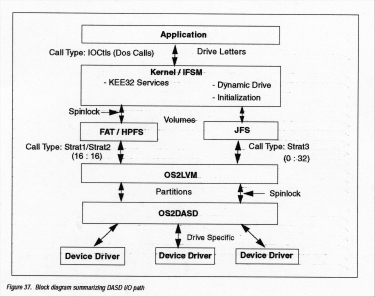|
|
 |
 |
 |
 |

Notes on OS/2 Disk Usage II - The Logical Volume Manager
By: Walter Metcalf
Previous
1
2
3
Next
Key Components of the LVM
The LVM comprises three main components by which it performs its various functions.
- Installable File System Manager (IFSM) Kernel.
Although this is not a new component, it has been changed so that whereas it formerly
communicated with the DASD system in terms of physical/logical location, it now communicates in
terms of logical volumes. This is done by introducing a new translation module called OS2LVM.DMD,
which provides not only the logical volume translation, but also dynamic drive letter allocation,
dynamic mounting, and unmounting of drives during the partitioning processing. In addition,
parts of the IFSM have been converted from 16-bit to 32-bit. producing further performance
gains.
- Device Manager - OS2LVM.DMD
This new module sits between the IFSM and OS2DASD modules providing the logical view of the DASD
to the OS/2 file system. OS2LVM.DMD also does Bad Block Relocation for JFS.
- NOTE: The statement BASEDEV=OS2LVM.DMD must immediately follow the BASEDEV=OS2DASD.DMD
statement in config.sys.
- DASD Device Manager - OS2DASD.DMD
OS2DASD has been modified to become the physical interface to the DASD I/O subsystem. Requests are
received from the OS2LVM as physical read/writes to physical partitions. OS2DASD has also been
enhanced in key places by adding 32-bit (called Strat3) entry points so that calls from the
KEE32 kernel, which are made in 32-bit mode (see diagram), benefit from the 32-bit flat address
model and thereby result in improved performance.
The following diagram illustrates the relationship between the various modules of the new disk I/O
subsystem:

Previous
1
2
3
Next
Unless otherwise noted, all content on this site is Copyright © 2004, VOICE
|
 |
 |
 |
 |
|
|











